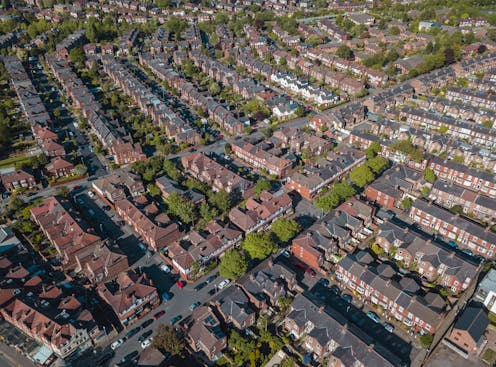New right-to-buy scheme could trap people in poverty – here’s what could really make houses affordable
- Written by Alexander Tziamalis, Senior Lecturer in Economics, Sheffield Hallam University

The UK government has announced plans[1] to make mortgages available to people on benefits, allowing more of them to buy their own homes. Housing association tenants will also be offered the chance to buy their properties at a discount. Immediately compared to a similar policy championed by Margaret Thatcher in the 1980s, this is being sold[2] as a way of helping “millions realise the dream of home ownership”.
In principle, a right-to-buy scheme could indeed be a useful tool to help people, provided all of the sold properties are replaced. But the real solution to affordable housing for everyone is far simpler – and comes down to building more houses.
Meanwhile, a quick glance at the wider economic picture shows that this policy idea is far from well timed. Inflation is high and likely to remain much higher[3] than the levels we have become used to, and people relying on housing benefits will probably struggle the most to make ends meet[4].
To combat inflation, interest rates are increasing, which is not good news for anyone paying off a mortgage. And for those receiving benefits, these payments would probably account for many times the mortgage holder’s annual income. A recession, even if mild, would typically hit those on lower incomes disproportionately.
All of this means great uncertainty for anyone on eroding incomes with increasingly uncertain employment prospects. If buying a house with benefits is going to help people rather than trap them in poverty in a deteriorating economic environment, it will need to guarantee ultra low interest rates for mortgages for a long time to come.
And for those whose incomes fall significantly behind inflation rates, or even lose their jobs, any right-to-buy scheme should come with a more generous benefits package.
Looking at the history of right-to-buy policies, another obvious issue is that many people will seek to make a profit[5] by buying the property at a substantial discount and then selling it as soon as they can. About 40% of properties sold through right-to-buy in the past have ended up in the hands of private landlords[6] who tend to charge much more than housing association rents.
In such a scenario, the UK government would have spent as much as £3 billion of public money creating a windfall for the few[7] who were able to make a profit from buying and selling.
To be successful then, the policy should include strict checks as to the usage and sale of these properties. Receiving a great benefit from public funds should come with obligations – and repercussions for dishonesty.
Another critical issue is mortgage availability. For those who receive housing benefits, even a 95% mortgage could prove daunting. This could lead to potential homeowners resorting to high interest personal loans or even loan-sharks to secure a 5% deposit.
Finally, the idea depends on the willingness of housing associations to sell their properties to tenants. Housing associations are not part of the government and in the past they have successfully resisted similar efforts[8] towards right-to-buy schemes.
They were right to do so. For it is important to remember that the government needs to help not just this generation of people in need, but also the generations that will follow.
Unless the properties sold are somehow replaced one-for-one, and crucially, like-for-like, the total stock of affordable housing will dwindle further. Their number has already been reduced by about 1.3 million homes[10].
A right-to-buy scheme is not necessarily a bad idea, nor is it destined to fail. It’s a scheme that could indeed make people on low incomes happier and wealthier in the long term.
But the fundamental housing issue in the UK is a chronic undersupply of properties for the country’s expanding population. The lack of new properties into the market, combined with record low interest rates and also government policies which seek to prop up house values[11] have led to house prices rising 74%[12] in only ten years.
If the country built more, property prices would slowly return to more affordable levels. A generous proportion of these new builds (or conversions) should of course be affordable, and that’s where the real solution lies.
Quality family apartments like the ones seen in parts of Europe[13], conversions of unused high-street buildings and brownfield developments should be the direction of travel. Why not set up a national company to survey land, assess population needs, and do a lot of the design and even building themselves?
This kind of investment would pay off in terms of a happier population, with less mortgage debt. Otherwise, we run the risk of a populist knee-jerk reaction to a deteriorating housing availability, creating problems that could plague generations to come[14].
References
- ^ plans (www.theguardian.com)
- ^ being sold (www.bbc.co.uk)
- ^ remain much higher (theconversation.com)
- ^ make ends meet (ifs.org.uk)
- ^ make a profit (inews.co.uk)
- ^ hands of private landlords (www.theguardian.com)
- ^ windfall for the few (www.theguardian.com)
- ^ resisted similar efforts (www.insidehousing.co.uk)
- ^ Shutterstock/sommart sombutwanitkul (www.shutterstock.com)
- ^ about 1.3 million homes (www.theguardian.com)
- ^ prop up house values (theconversation.com)
- ^ rising 74% (www.theguardian.com)
- ^ ones seen in parts of Europe (internationalsocialhousing.org)
- ^ plague generations to come (policyexchange.org.uk)







